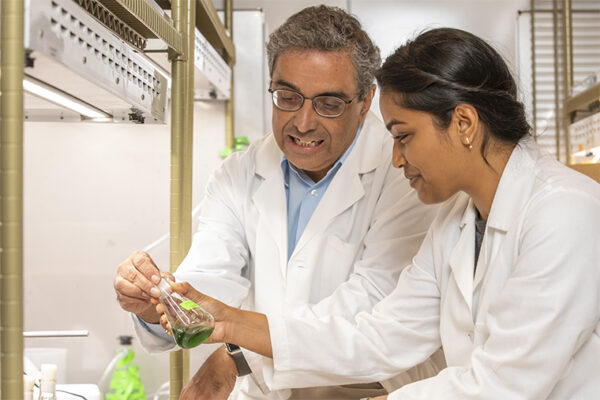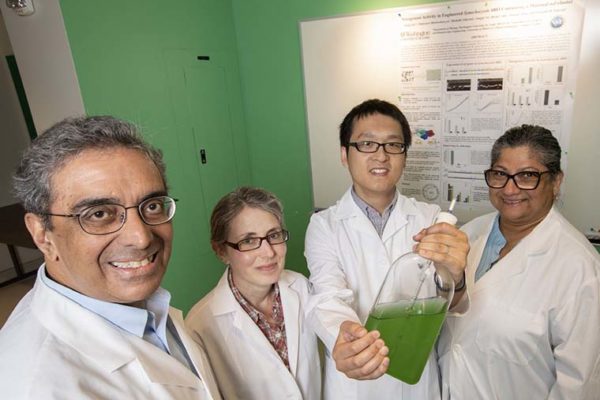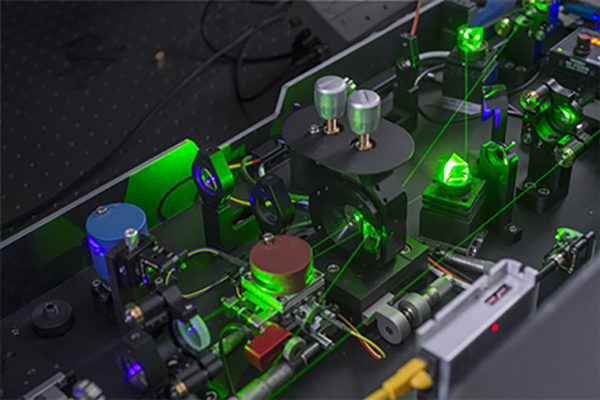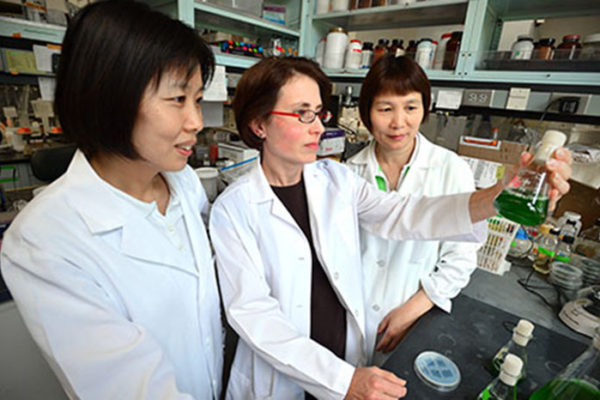NSF funds research on nitrogen fixation
Himadri B. Pakrasi, professor of biology in Arts & Sciences and director of InCEES, was recently awarded a $1.2-million grant for a collaborative study of cyanobacteria with the ultimate purpose of producing nitrogen-fixing crop plants.
Researchers engineer bacteria that create fertilizer out of thin air
A team at Washington University in St. Louis has created a bacteria that uses photosynthesis to create oxygen during the day, and at night, uses nitrogen to create chlorophyll for photosynthesis. This development could lead to plants that do the same, eliminating the use of some — or possibly all — man-made fertilizer, which has a high environmental cost.
Zhang receives NASA early-career faculty award
Fuzhong Zhang, PhD, assistant professor of energy, environmental and chemical engineering at Washington University in St. Louis, has received an early-career faculty award from NASA.
Scientists stitch up photosynthetic megacomplex
In Science, scientists at Washington
University in St. Louis report on a new technique that allowed them to extract a photosynthetic megacomplex consisting of a light antenna and two reaction centers from the membrane of a cyanobacterium. This is the first time an entire complex has been isolated and studied as a functioning whole.
Creating plants that make their own fertilizer
Much of modern agriculture relies on biologically
available nitrogenous compounds (called “fixed” nitrogen) made by an
industrial process developed by German chemist Fritz Haber in 1909. Himadri Pakrasi, PhD, a scientist at Washington University in St. Louis, thinks it should be possible to design a better
nitrogen-fixing system. His idea is to put the apparatus for fixing
nitrogen in plant cells, the same cells that hold the apparatus for
capturing the energy in sunlight. The National Science Foundation just awarded Pakrasi and his team $3.87 million to explore this idea further.
$ 2.2 million Department of Energy grant to build a fuel-producing bacterium
The Department of Energy has funded a three-university collaboration led by Washington University in St. Louis to approach the problem of algal fuels systematically.In a two-step project, the team will first attempt a comprehensive understanding of the metabolic machinery of selected cyanobacterial strains and then implement that understanding by assembling a novel bacterium with the machinery needed to produce fuel molecules. They will be bringing to bear on the problem of algal fuels the most sophisticated approaches contemporary biology now has to offer: systems biology and synthetic biology.
Champion hydrogen-producing microbe
The cyanobacteria are famous for releasing the oxygen that made the Earth a hospitable planet, but some strains also have a hidden talent for producing hydrogen gas, a potential biofuel. With the help of a few metabolic tricks, a lab at Washington University has coaxed one such strain to produce champion levels of the gas.
Is bacterium renewable source of energy?
A team of researchers headed by biologists at Washington University in St. Louis has sequenced the genome of a unique bacterium that manages two disparate operations — photosynthesis and nitrogen fixation — in one little cell during two distinct cycles daily.
Sequenced photosynthetic bacterium has rare linear chromosome
Unicellular nitrogen-fixing cyanobacteriaA team of researchers headed by biologists at Washington University in St. Louis has sequenced the genome of a unique bacterium that manages two disparate operations — photosynthesis and nitrogen fixation — in one little cell during two distinct cycles daily.
Is bacterium renewable source of energy?
A team of researchers headed by biologists at Washington University has sequenced the genome of a unique bacterium that manages two disparate operations — photosynthesis and nitrogen fixation — in one little cell during two distinct cycles daily.
View More Stories




